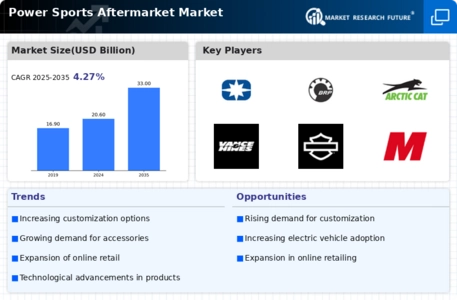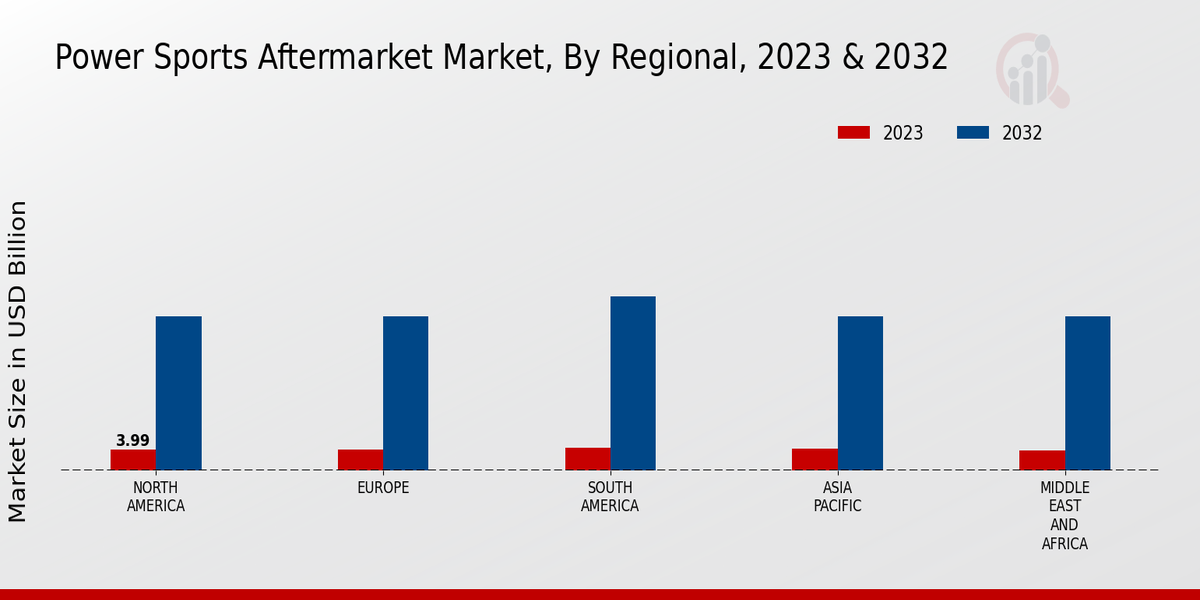Market Growth Projections
The Global Power Sports Aftermarket Market Industry is poised for substantial growth, with projections indicating a market size of 20.6 USD Billion in 2024 and an anticipated increase to 33.0 USD Billion by 2035. This growth trajectory suggests a robust demand for aftermarket products and services, driven by factors such as rising recreational participation and technological advancements. The expected CAGR of 4.37% from 2025 to 2035 underscores the industry's resilience and adaptability in a changing economic landscape. As consumer preferences evolve, the aftermarket sector is likely to innovate and expand, ensuring its relevance in the global market.
Growing E-commerce Platforms
The rise of e-commerce platforms significantly influences the Global Power Sports Aftermarket Market Industry. Online retailing offers consumers a convenient avenue to purchase aftermarket parts and accessories, often at competitive prices. This shift towards digital shopping aligns with changing consumer preferences, particularly among younger demographics who favor online transactions. As a result, aftermarket suppliers are increasingly investing in their online presence to capture this growing market segment. The convenience of online shopping, coupled with the ability to compare products and prices, enhances consumer engagement and drives sales. This trend is expected to contribute to the overall growth of the market, as e-commerce continues to expand.
Increasing Recreational Participation
The Global Power Sports Aftermarket Market Industry experiences a notable boost from the rising participation in recreational activities. As more individuals engage in outdoor sports, the demand for power sports vehicles and their aftermarket components surges. In 2024, the market is projected to reach 20.6 USD Billion, driven by a growing consumer base that seeks adventure and leisure. This trend is particularly evident in regions with expansive natural landscapes, where off-road vehicles and personal watercraft are increasingly popular. The industry's growth is further supported by the increasing availability of financing options, making power sports more accessible to a broader audience.
Technological Advancements in Vehicles
Technological innovations play a pivotal role in shaping the Global Power Sports Aftermarket Market Industry. The integration of advanced features such as GPS navigation, enhanced safety systems, and improved fuel efficiency in power sports vehicles attracts consumers looking for modern solutions. As manufacturers continue to innovate, aftermarket suppliers are also compelled to adapt, offering compatible upgrades and accessories. This dynamic creates a symbiotic relationship between vehicle manufacturers and aftermarket providers, fostering growth. The anticipated CAGR of 4.37% from 2025 to 2035 indicates a sustained interest in technologically advanced power sports, further solidifying the industry's position in the global market.
Rising Disposable Income and Urbanization
The Global Power Sports Aftermarket Market Industry benefits from rising disposable incomes and urbanization trends. As more individuals attain higher income levels, their purchasing power increases, allowing for greater investment in recreational activities, including power sports. Urbanization contributes to this trend, as city dwellers seek outdoor experiences and adventure. The market is projected to grow to 33.0 USD Billion by 2035, reflecting the increasing willingness of consumers to spend on leisure activities. This demographic shift not only expands the consumer base but also encourages the development of new products tailored to urban lifestyles, further driving the aftermarket sector.
Environmental Regulations and Sustainability
The Global Power Sports Aftermarket Market Industry is also shaped by increasing environmental regulations and a growing emphasis on sustainability. As governments worldwide implement stricter emissions standards, manufacturers are compelled to develop cleaner, more efficient power sports vehicles. This shift not only influences the design and production of new vehicles but also creates opportunities within the aftermarket sector for eco-friendly parts and accessories. Consumers are becoming more environmentally conscious, leading to a demand for sustainable options. This trend may drive innovation in the aftermarket industry, as companies seek to align their offerings with consumer values and regulatory requirements, potentially enhancing market growth.










